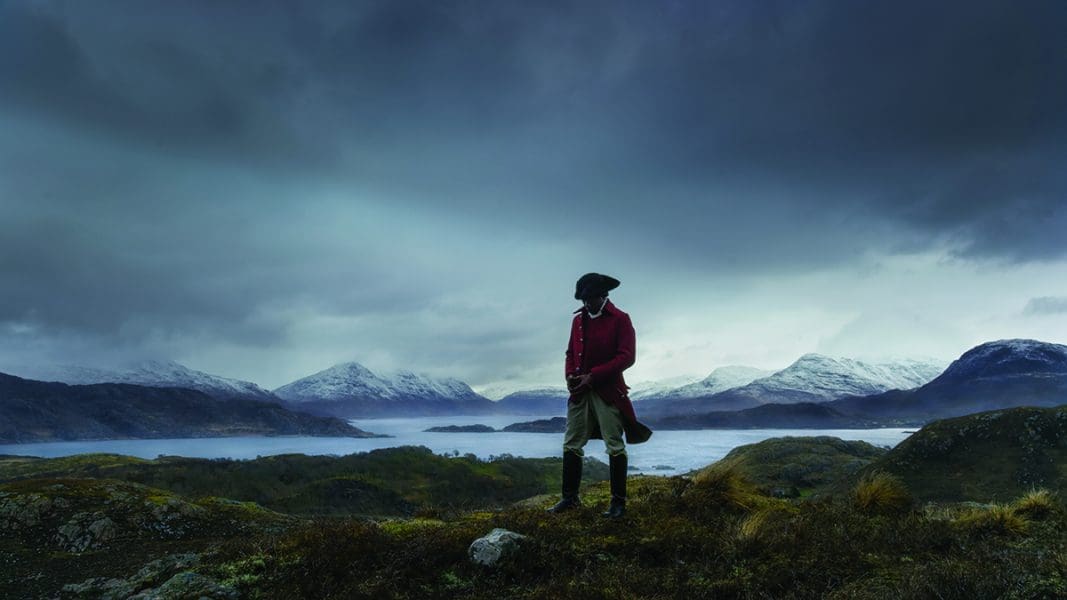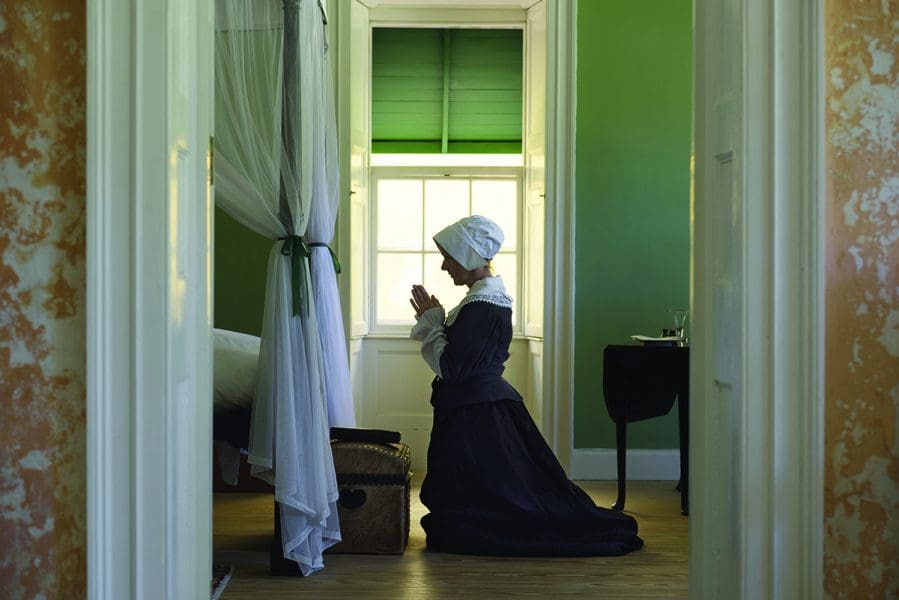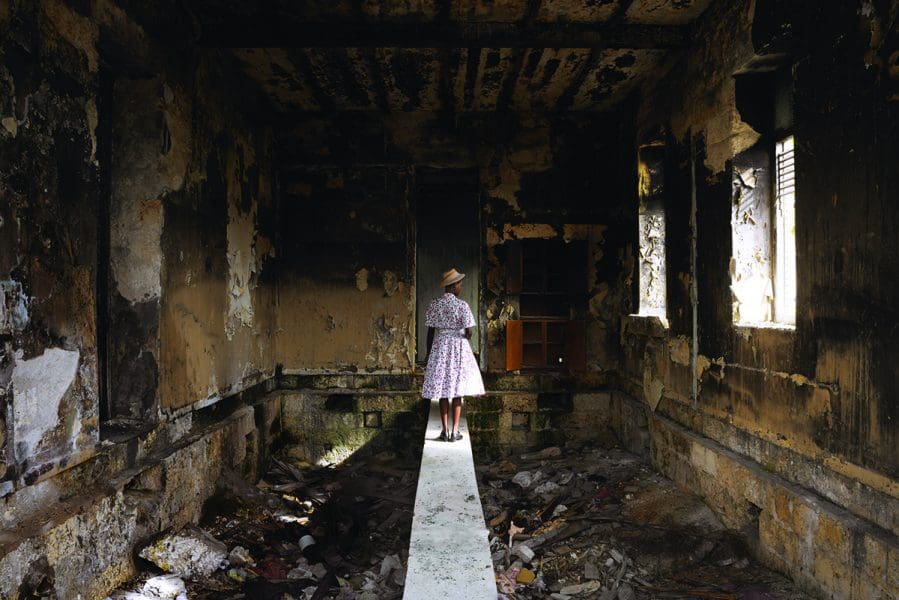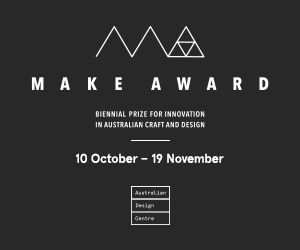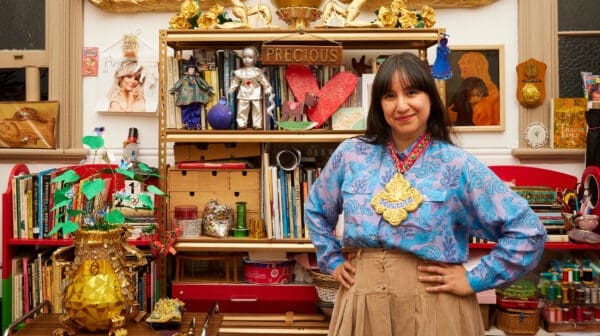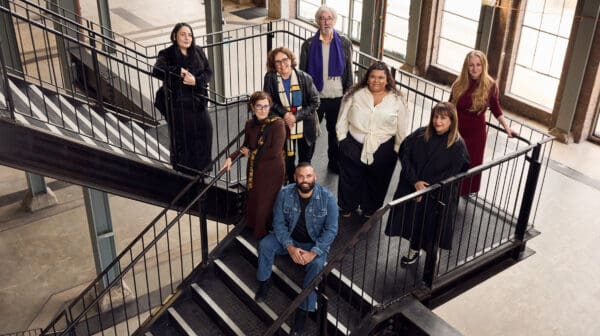John Akomfrah’s immersive presentation of two major video works at John Curtin Gallery bears the weight and darkness of two different histories. Vertigo Sea broods over the desperation and tragedy that characterises our relationship with the sea. Auto Da Fé, seen here in its Australian premier, is a choreographed, otherworldly re-enactment of the upheaval and loss caused by migration. Intense, absorbing, visually spectacular and at times harrowing, these two video works, in their own ways, describe a fragile world hewn by human ruthlessness and unyielding natural forces.
In Auto Da Fé, groups of actors in period costume (from colonial aprons to aviator sunglasses) are transplanted into a series of crumbling factory yards, abandoned town centres and eerily unpopulated public spaces. There, they silently reconstitute the history of each site through the performance of repetitive gestures: waving goodbye, raising open palms, clenching fists. Translated from Inquisition-era Portuguese, auto-da-fé refers to the Catholic practice of forced public atonement, usually in the form of physical punishment. Akomfrah’s hypnotic film portrays four specific waves of migration that resulted in the persecution of cultural groups including the Sephardic Jews, and Christian and Yazidi minorities in Iraq. The injustices they experienced reverberate through the gestures, steps and poses of each performer.
The child of Ghanaian activists, Akomfrah’s own family fled to the UK when the artist was four. Auto Da Fé, which won this year’s £40,000 Artes Mundi prize for international contemporary art, underscores the continuing intolerance directed at incoming migrant communities, despite the horror and necessity which drive them to flee. The histories animated by this work share a common humanity with Akomfrah’s own experience, and might serve to remind us of the extremity of today’s global refugee crisis.
A sensation at the 2015 Venice Biennale, Vertigo Sea appears across three screens, quickened by a sumptuous 7.1 soundtrack weaving together quotations from novels, and historical logs, thunderous oceanic sound effects and affecting instrumental soundscapes.
The film courses and flows like water, themes and motifs appearing in waves. Some minutes are occupied by polar bear hunting, others by an Edwardian figure awaiting the return of some anonymous seafarer. Then a cascade of diving gulls, turquoise icebergs, swarming stingrays, breaching whales, foundering swimmers, murderous orcas, slave trader ships, storms, nets and creaking gunnels. Unbounded by time or distance, Vertigo Sea combines a cacophony of footage and narrative that spans the whole globe and hundreds of years of history. Each fragment of sound or moving image reiterates the chaos of the sea: its astounding beauty, untold variety of colours and forms, and eternal lack of regard for life, human or animal.
Structurally, Vertigo Sea and Auto Da Fé resemble poetry more than cinema. They unfold with a certain meter and pace, without any ordered narrative. Their dramatic imagery and motifs return in refrains, are inverted or transposed, and evoke many outside stories: Vertigo Sea, for instance, stirs a memories of David Attenborough documentaries; Friedrich’s painting, Wanderer Above a Sea Fog; the voyages of Shackleton or the Sea Shepherd; and selachophobia (the fear of sharks).
Akomfrah’s works are accompanied by a brief documentary which reveals the artist’s intensive, years-long development and production process, his collaborative relationships and cross-disciplinary approach to making art films.
While lengthy in video art terms (patrons need two hours to drink it all in), the pitch-dark vessel of John Curtin Gallery, like a sensory-deprivation tank, wipes out any restlessness or sensation of time passing. In this environment, the videos effect some kind of suction on their viewers, who are compelled, by the swelling audio and theatricality of the footage, to widen their eyes and be inundated by the experience.
John Akomfrah is presented as part of the Perth International Arts Festival.
John Akomfrah
John Curtin Gallery
7th February – 30th April 2017





